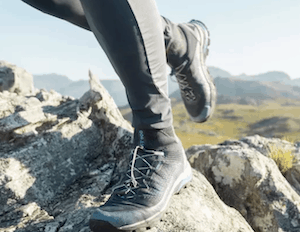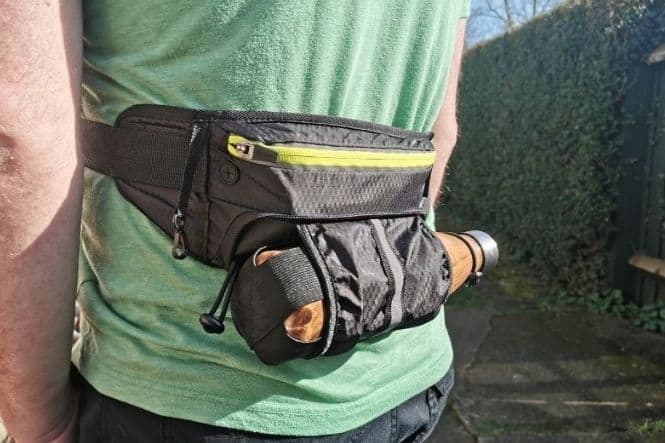Summer is the perfect time of year to get out and about and explore everything that nature has to offer. In the UK, summertime can be a little unpredictable. While the temperature usually remains consistently warm throughout the months of June, July and August, there’s always a chance of rain. And don’t forget that if you are planning a multi day hike, things might get a little chilly once the sun goes down.

So, if you’re heading off on a hiking adventure in the summer, it’s essential that you go properly prepared; and that includes what you choose to wear. In this guide, we will be telling you everything you need to know to be able to kit yourself out for those summer hikes without having to worry about a thing.
Things To Think About Before Choosing Your Summer Hiking Gear
When we talk about summer, it’s quite easy to simply imagine a gloriously hot, sunny day. This is the case in a lot of places but of course, there are so many variations on the weather during summer. It largely depends on where you are hiking. For example, if you’re hiking along a coastal path where the humidity is relatively high, you’d dress dramatically differently than if you were hiking through a very dry environment.
So, before you do anything, you’ll need to consider where you’re headed and what gear is going to be most suitable.
Choosing The Right Fabrics
When you are choosing clothing for a summer hike, you will need to consider your fabric choices. Now, while it doesn’t matter quite as much as it does when choosing winter hiking clothes, your fabric choice will make a difference to your comfort while on the trail.
Many people opt for cotton but this material is only really suitable if you’re doing a shorter hike. ON longer hikes, you may find that cotton begins to chafe causing nothing but discomfort and that’s the last thing that anyone wants when they’re trying to enjoy the scenery.
Going for moisture wicking fabrics is a must, especially in hot weather. You’re going to sweat when you’re hiking in the heat; there’s no getting away from that. But opting for moisture wicking materials will mean that you stay as dry as possible and that any kind of chafing is reduced, if not removed entirely.

Think About Layers
It might seem a little odd to want to wear layers when the sun is blazing down and the mercury is rising. However, there is a method to this madness. For starters, there may be dips in the temperature, especially if you’re headed off on a multi day hike. In the evenings and overnight, things can get quite chilly so it’s important to have layers to keep that body heat in.
Moreover, wearing layers, especially those with longer sleeves or legs can offer better protection from the sun. Depending on the trail you’re hiking, you may be exposed to direct sunlight for most of the day and as we all know, this can cause sunburns and is not good for the skin. However, by adding a very lightweight top layer such as a thin jacket, you are offering yourself more protection. If you’re going to do this, make sure that the material is breathable.
Do I Wear Trousers or Shorts For Summer Hiking?
One of the biggest musings of the summer hiker is whether to kit themselves out with a pair of good hiking trousers or go for shorts. The truth be told, there’s pros and cons to both options so you will need to think about your personal needs before making a decision.
If you know that the weather is going to be super hot then shorts are the most obvious choice. They won’t cause the legs to sweat and will ensure lovely airflow around the legs as you move along the trail.
That said, some people do not find shorts comfortable so opt for trousers. Additionally, the main benefit of wearing trousers is that they provide you with greater protection from nature; things like UV rays, insects and even overgrown foliage that may contain thorns or prickles. Of course, if you are going to wear trousers, you’ll want to look for some that are as breathable as possible.
What About My Shirt?
Again, the type of shirt you choose when hiking in summer will largely come down to personal preference. Some people like to wear a short sleeved shirt as this will help to avoid feeling suffocated and overheating. However, if you’re going to choose a short sleeved T shirt, we would recommend going for one that properly covers the shoulders. Wearing something like a tank top or vest may feel cooler but those UV rays will be hitting your neck and shoulder directly and you may end up with a nasty sunburn.
Alternatively, you could opt for a lightweight long sleeved shirt that is guaranteed to offer better UV protection. However, you must be savvy about the type of material the shirt is made from if you want to avoid feeling too hot and sweaty.
Primarily, synthetic materials like polyester and nylon are great as they are very breathable. But if you want a natural fabric, then something like merino wool is great for regulating temperature. In any case, we’d suggest going for something that has ventilation panels to make sure that you stay extra cool and dry.
Keeping Your Feet Comfortable On A Summer Hike
If you have ever experienced the pain of blisters or sores as a result of poor footwear choices, you will know how important it is to choose wisely. This is even more important during the summer months as perspiration and moisture are both leading causes of blisters, as well as heat and friction.
So, one of the first things to think about is whether your chosen hiking shoes are breathable and moisture wicking. It’s also imperative to make sure that they have a perfect fit. The last thing you want is to get halfway along a trail to find that your feet are cut to shreds and there’s not a thing you can do about it.
Wearing bulky hiking boots in the summer can be an unpleasant experience so many people choose a good pair of trail runners. Provided that they offer a good fit and are comfortable, there’s no reason you cannot wear these even on a more rugged or wild trail. Just make sure that you have tested them out on shorter hikes before hitting the more challenging paths.
Alternatively, some hikers like to wear sandals for their summer outings. There’s nothing wrong with this per se, but you should keep in mind that your feet will be more exposed so if the trail is very rough, it might be worth reconsidering your choice. However, for less demanding environments, a quality pair of hiking sandals are ideal, especially if you suffer with excess perspiration on the feet. Again, test them out and break them in a little before going on a longer hike to ensure maximum comfort.
Finally, for your feet, you will need a good pair of socks. These will add an additional layer of protection against friction but can also be great for keeping your feet cool. It sounds odd but it’s true, if you go for something like merino socks, these are breathable and regulate temperature. Don’t be tempted by cotton socks, however, as these do not dry quickly so you’ll end up with moist feet that are more prone to chafing.

Sun Protection
If nothing else, hikers should prepare themselves for UV exposure. While the UK may not be the hottest or most tropical country in the world, the sun can get pretty strong here in the summer months. For this reason, you must make sure that your head, skin and eyes are protected.
Investing in a good quality set of sunglasses will keep the glare off and protect the delicate eye area from UV exposure.
You should also consider a wide brimmed hat as this will not only offer protection to the head but also covers the face and, when the hat is large enough, may even shade the neck and shoulders. Just make sure to go for a breathable material and choose a hat that has a moisture wicking band on the inside.
Of course, it doesn’t take us to tell you that wearing a high factor sun protection lotion is also of the utmost importance. Take regular breaks while hiking to top up your lotion and, if you begin to burn, stop and cover the area with a lightweight jacket to prevent further burning.
Don’t Forget To Pack Some Essentials
Now that you have got your clothing down to a T, you will need to think about what to pack in your hiking pack. For longer hikes, you’ll likely have a whole host of gear to take with you, including food, blankets, a tent and much more. But these few items are a must when hiking in summer.
Take plenty of water even if you are only going on a short hike. Staying hydrated in the heat is so important especially when you’re in a remote area where help cannot be instantly accessed. Many hiking packs come with a water bottle holder or hydration pack so make the most of this feature.
While the sky may look clear when you initially head off, it doesn’t take much for the weather to turn and you may find yourself caught in a shower. For this reason, summer hikers are advised to always take a lightweight rain jacket.
There’s nothing more irritating than an insect bite or sting but they can be prevented through the use of sprays and repellents. Pack one of these products in your bag especially if you’re staying overnight as many biters come out at dusk.

Conclusion
If you’re anything like us, you’ll snap up the opportunity to indulge in a summer hike while the weather is warm and beautiful. However, this does come with some problems such as overheating, UV exposure and pesky bugs and insects.
But that doesn’t mean that you shouldn’t enjoy your summer hikes, you just need to choose the right gear. That way, you’ll be able to enjoy your surroundings and feel comfortable; it’s a win-win!

